Using a Racepak IQ3 Dash with a Modular ECU

About the Racepak system:
Racepak has its own implementation of CAN which it calls VNET. This is a 250 kbps bus, where different CAN IDs are allocated for different variables which can be transmitted and logged.
As well as the CAN IDs being broadcast to transmit data, there is a separate protocol which allows information about the data to be read and written (you can consider this the “settings”). Any scaling / offsetting is done in the sensor interface (or EFI interface) itself, and the dash only displays or logs these scaled data. Therefore to change units between metric and imperial, this must be done not in the dash setting, but in the device generating the data (in this case, the ECU).
The pinout on the VNET connector is as follows:
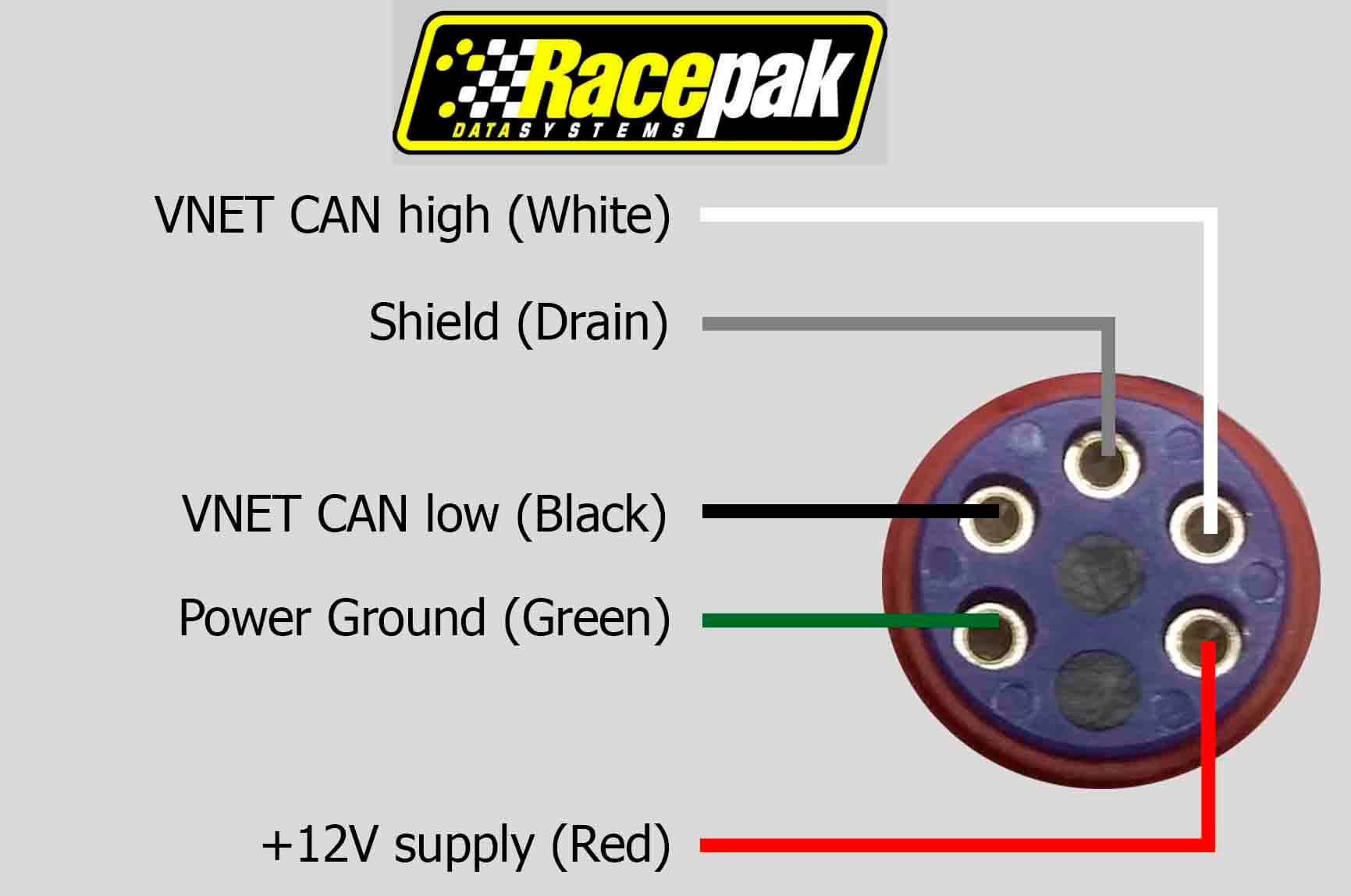
The wire colours of the VNET cable which we used to wire up are as follows:
Racepak has its own implementation of CAN which it calls VNET. This is a 250 kbps bus, where different CAN IDs are allocated for different variables which can be transmitted and logged.
As well as the CAN IDs being broadcast to transmit data, there is a separate protocol which allows information about the data to be read and written (you can consider this the “settings”). Any scaling / offsetting is done in the sensor interface (or EFI interface) itself, and the dash only displays or logs these scaled data. Therefore to change units between metric and imperial, this must be done not in the dash setting, but in the device generating the data (in this case, the ECU).
The pinout on the VNET connector is as follows:

The wire colours of the VNET cable which we used to wire up are as follows:
| Pin | Colour | Function | Connection |
| Green | Power ground | No connection required if the dash has its own power. Otherwise you can connect this to power ground at the ECU to provide power to the dash | |
| Red | 12V supply | No connection required if the dash has its own power. Otherwise you can connect this to ignition switched power at the ECU to provide power to the dash | |
| Black | CAN low | CAN L – J2-23 on M2000 / M6000 | |
| White | CAN high | CAN H – J2-15 on M2000 / M6000 | |
| Drain | Shield wire | No connection |
The two other pins are unused on the VNET connection, but on the Haltech branded IQ3 are the CAN connections to the Haltech ECU.
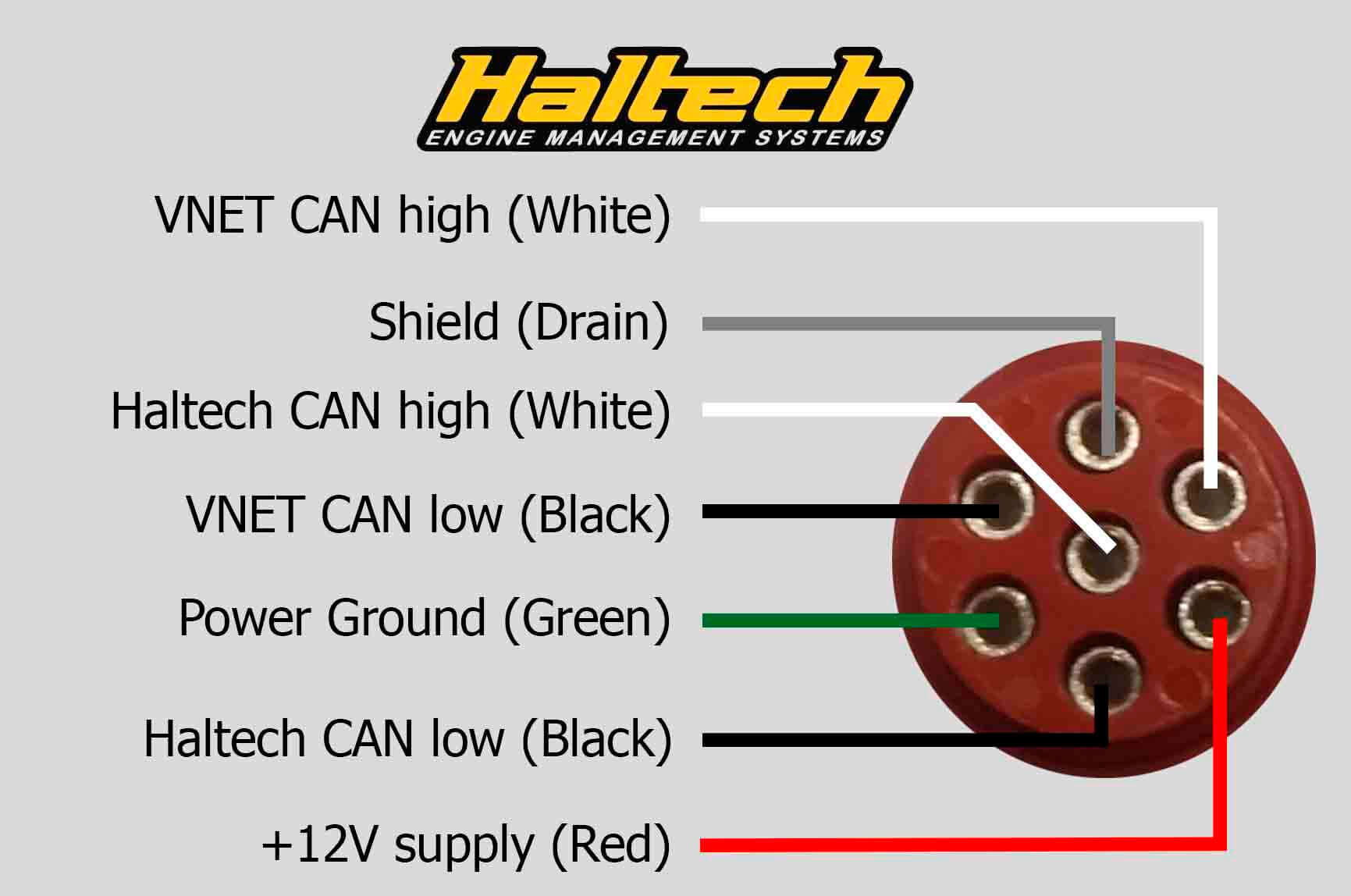
ECU settings:
The following ECU settings must be set up to use the Racepak mode directly:
- CAN bitrate = 250 kbps
- CAN termination = ON, if this is the last or only device on the chain. Otherwise if it’s in the middle of the chain then CAN termination = OFF
- CAN output mode = Racepak
- Unit selections according to your personal preference.
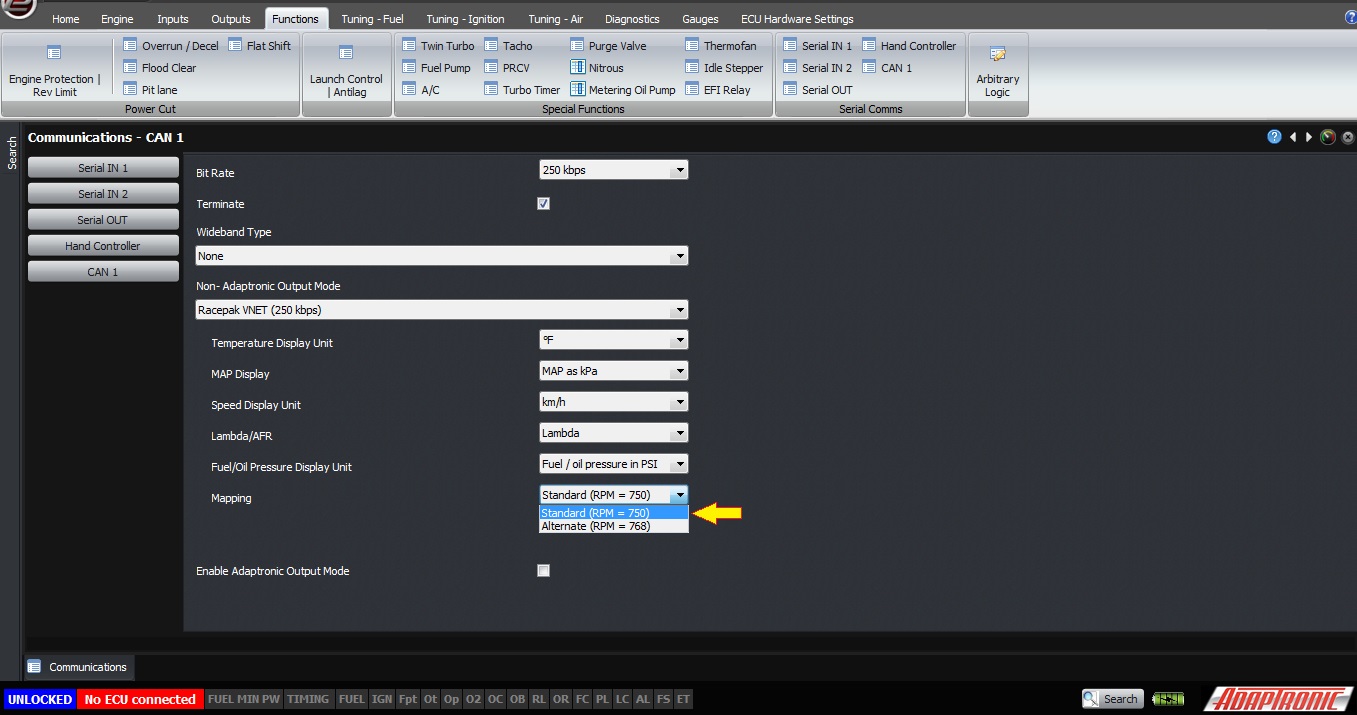
The following unit selections are available:
| Setting name |
Options |
Scaling |
| Temperature |
Celcius Fahrenheit |
Native = Celcius (0.1 degree resolution) Fahrenheit = C * 9/5 + 32 |
| Speed |
km/h mph |
Native = km/h (0.1 km/h resolution) mph = km/h / 1.6 |
| Lambda |
Lambda Petrol AFR |
Native = lambda (0.001 resolution) Petrol AFR = lambda * 14.7 |
| Fuel / oil pressure |
kPa PSI |
Native = kPa (0.1 kPa resolution) PSI = kPa *0.145 |
| MAP |
kPa MGP, kPa MGP, PSIg MGP, PSIg / inHg |
Native = kPa absolute (0.1 kPa resolution) MGP = MAP – baro (still in kPa) MGP PSIg = MGP * 0.145 MGP PSIg = MGP * 0.145, MGP >=0 MGP * 0.290, MGP <= 0 |
Dash settings:
Start with the IQ3 configuration file supplied by Adaptronic. This has the channels for the ECU data already loaded, so that they can be selected on the dash screen.
IQ3_Config_Modular.rcg
IQ3_Config_Modular_Remap_forHaltechIQ3V2.rcg
If you attempt to read out the full VNET settings, you will be presented with this warning:

You should click “no to all” to avoid the channels being deleted.
Note also that the Datalink software will allow you to see settings in these channels (eg scaling), but changing them will have no effect. To change the scaling for different units, please use the Adaptronic software Eugene.
The following are the data generated by the Adaptronic ECU in Racepak output mode, as of firmware 0.140:
| CAN address (hex) (remap address in brackets) |
Variable name |
Decimal places |
Units |
| 750 (768) |
RPM (engine speed) |
0 |
RPM |
| 751 (769) |
ECT (coolant temp) |
1 |
°C, °F |
| 752 (76a) |
Oil Pressure |
1 |
kPaG, PSIg |
| 757 (76f) |
Ignition advance (leading) |
1 |
° BTDC |
| 755 (76d) |
IMAP (intake manifold absolute pressure) |
1 |
kPaA, kPaG, PSIg, PSIg / -inHg |
| 753 (76b) |
Pedal / TPS |
2 |
% |
| 75A (772) |
Lambda |
2 |
Lambda, petrol AFR |
| 75F (777) |
Vehicle speed |
1 |
km/h, mph |
| 756 (76e) |
Fuel pressure (gauge) |
1 |
kPaG, PSIg |
| 758 (770) |
Injector 1 duty |
2 |
% |
| 754 (76c) |
MAT (air temperature) |
1 |
°C, °F |
| 765 (77d) |
EGT1 |
1 |
°C, °F |
| 760 (778) |
Transmission Gear |
2 |
(I don’t know why gear has 2 decimal places by default in the Racepak system) |
| 761 (779) |
Battery voltage |
2 |
V |
| 766 (77e) |
Oil temperature |
1 |
°C, °F |
The default function is to have the remap disabled, and the base address = 750. The remap is for compatible which will be explained later for the Haltech IQ3 dash.
Haltech cobranded IQ3
There are at least three versions of the Haltech IQ3.
Early version:
The first version read the Haltech V1 protocol. This was actually based on the AIM protocol. The Modular ECU can output this protocol by selecting:
- The output mode as Haltech V1
- The bit rate as 1 Mbps
- Terminate = ON
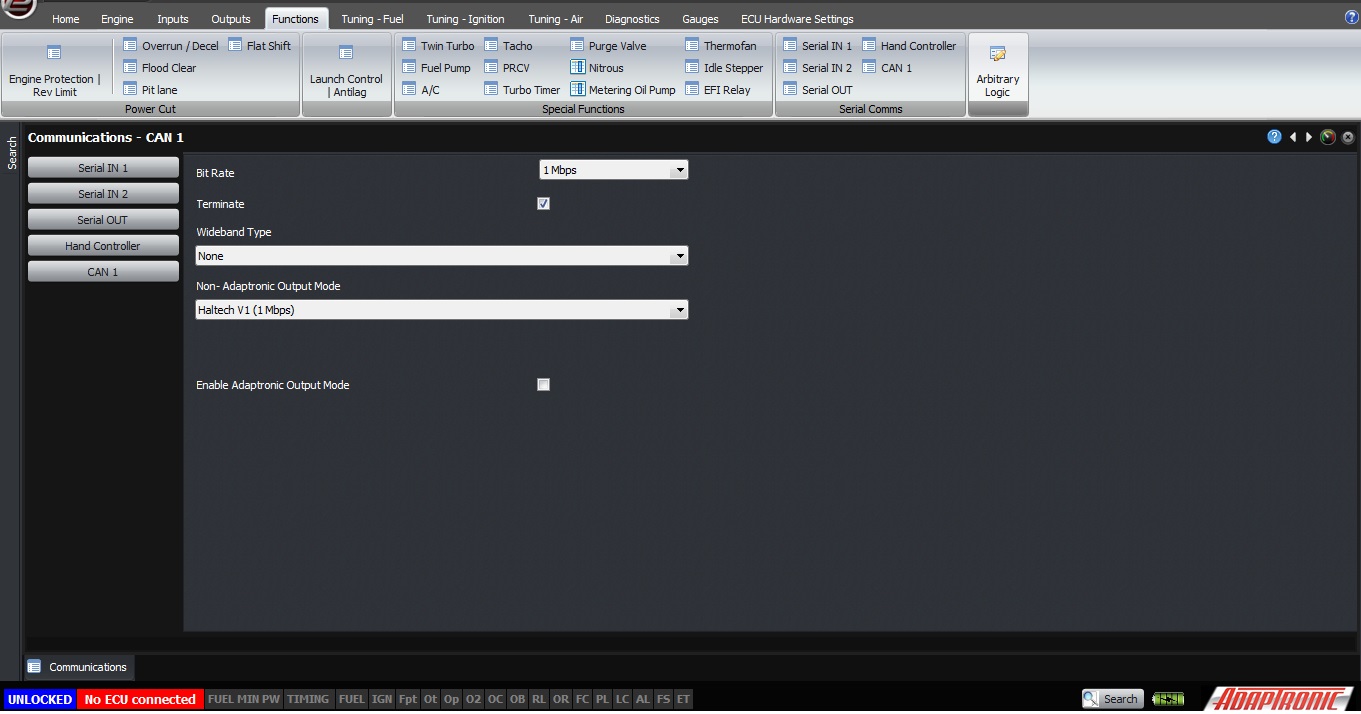
The CAN output from the ECU must be connected to the Haltech CAN pins on the red connector, shown above. These pins are different from the VNET CAN connection.
This works, however:
- The Oil Temperature channel was never implemented on the Haltech V1 ECU, so the ECU always sent zero on this channel. I believe it was never programmed correctly in the Racepak EFI module, because when we output the oil temperature to this channel, it is not displayed correctly on the dash.
- The same problem occurs with the EGT channel.
- MAP is output as gauge pressure (MGP); fuel and oil are also output as gauge pressure.
You can also user the method for the later version, described below.
Later version:
Haltech stopped supporting the V1 protocol on the Haltech IQ3 dash, and started to support the Haltech V2 protocol instead, but with additional authentication to ensure that the ECU connected is a Haltech ECU. So even outputting the Haltech V2 protocol option, this does not work with the Haltech IQ3 V2 dash.
The Haltech IQ3 dash supports VNET also, so you can use the VNET connection. However the data from the ECU then conflicts with the data from the inbuilt Haltech protocol converter. To counteract this, the Modular ECU allows you to remap the CAN IDs, by adding 18 (hex) to the address. For example, RPM becomes 768 instead of 750. These remapped addresses are described in the table above, and are already programmed in the file IQ3_Config_Modular_Remap_forHaltechIQ3V2.RCG.
For this connection you need to connect the Adaptronic CAN pins to the VNET pins, not the Haltech connection pins. On the red connector cable, these two pins are not connected, so you may need to buy a Racepak cable to be able to connect to these pins.
IQ3 Street:
The IQ3 street works using the connection described in the “early version” above (ie connecting the same way as a Haltech ECU), and selecting the Haltech V2 protocol. Although we haven’t
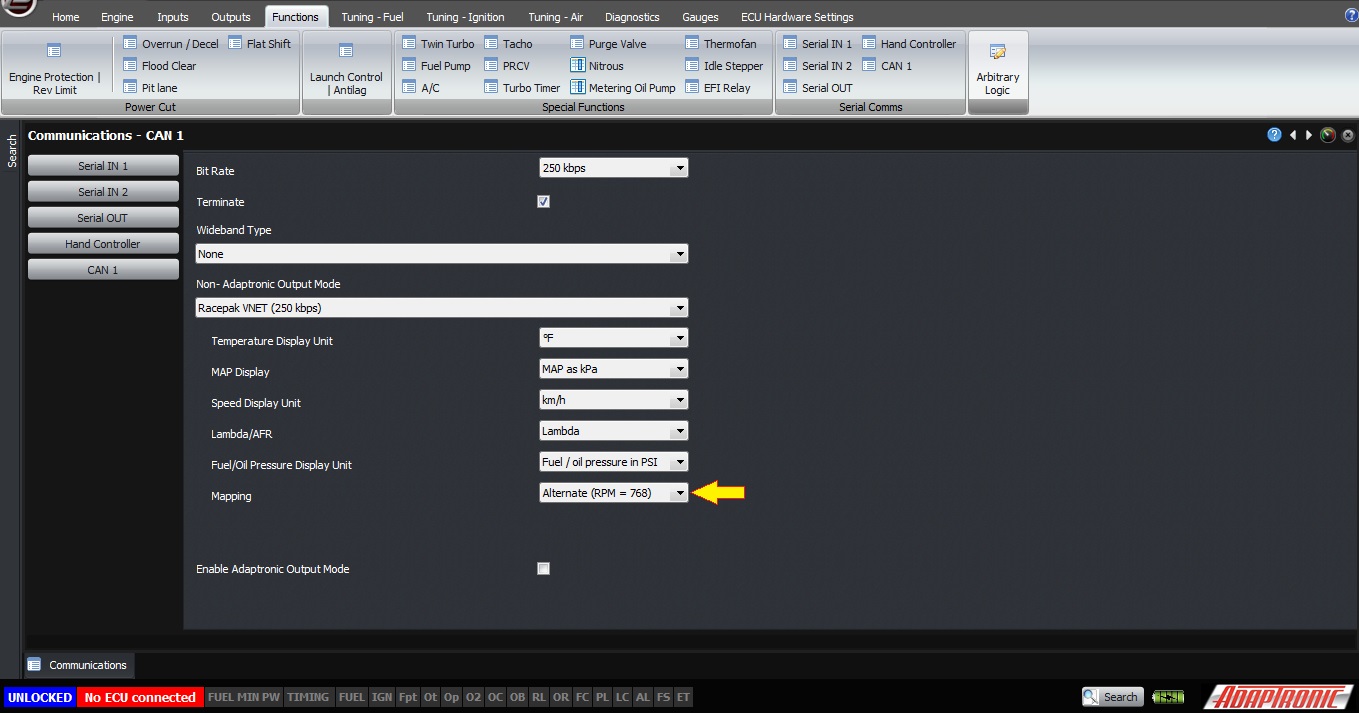
©2018 Adaptronic